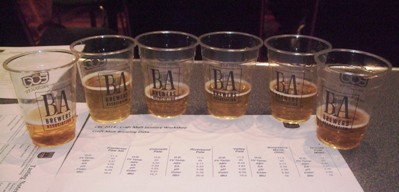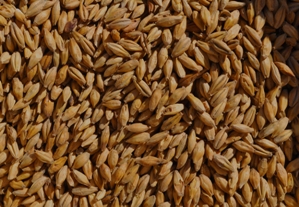It’s often said that hops are the varietals of the beer world, an idea that many brewers have seized on with numerous single hop brews constructed to show off the individual characteristics of a specific variety, so dedicated connoisseurs can get to know their Citra from their Challenger. But while the new primacy of the hop in drinkers’ consciousness has been most welcome, the resinous cones are by no means the sole ingredient of beer.
Yeast, too, is worthy of attention beyond the current penchant for Belgian variants and Brettanomyces in certain sections of the craft brewing world. Grains, meanwhile, are very much the unsung hero, despite making up the bulk of the dry ingredients, fuelling the fermentation and providing the backbone of the flavour.
So I was particularly intrigued to spot a sensory workshop focused on ‘craft’ malt in the seminar programme at the Craft Brewers Conference in Denver, Colorado, yesterday, even if it meant engaging my beer tasting faculties at the businesslike hour of 0900. The event was coordinated by the newly formed Craft Maltsters Guild, which began as a Google group in 2012 bringing together the growing number of speciality maltings that are springing up in the wake of the growth of craft brewing in North America. To qualify as a craft maltster, you need to be independently owned, source at least 50% of your ingredients locally and produce less than between five and 10,000 tonnes a year.
In preparation for this session, five maltsters collaborated with Christian Holbrook, a quality specialist at New Belgium in nearby Fort Collins, to create five beers showcasing different pale malts, plus a ‘control’ beer featuring that old stalwart of quality brewing, English Maris Otter pale malt. Christian brewed six beers on New Belgium’s pilot 10hl kit, all to the same very simple recipe.
Five of the beers were made with 200kg of a single pale malt mashed at 68°C, followed by a 75 minute boil with a modest 0.5kg of Oregon-grown Nugget hops, then fermented with New Belgium’s house ale yeast at 20°C. A sixth, gluten-free beer made with 100% millet needed a rather different treatment, but still featured the same quantity of grain and the same hop bill.

Six pale ales from different malts: left to right, Colorado, Grouse Millet, Frontenac, Riverbend, Valley, Maris Otter.
As soon as I got my nose over the first glass of beer I knew I was in for a sensory treat. I’ve got a sweet tooth, and love the fresh grainy sweetness of good malt. It’s always a delight to taste unfermented wort at a brewery – I treasure the memory of visiting Budvar in České Budějovice and sampling wort scooped fresh from the open lautering system as it gushed through a row of giant copper taps.
It’s a tendency I have to rein in when judging beers, as ‘wortiness’ is often a technical flaw, indicating a fermentation that hasn’t quite worked, leaving too much of the soothing breakfast cereal note of unfermented wort behind. Or it could be a stylistic issue if it isn’t balanced by sufficient hop character.
No such problem here as the beers were specifically brewed to showcase the flavour of the malt. But aside from the fact that all of them exhibited the expected fresh from the field graininess – you could almost smell the diesel fumes from the combine harvester – and cereal sweetness, the real surprise was how different they all were from each other.
The original gravity – the proportion of sugar extracted from the malt during mashing – varied slightly from beer to beer (for the technically minded, from 10.6° to 11.5° Plato, or 1043 to 1046, for the barley malt beers), while the alcohol content of the finished beers ranged from a gentle 3.4% to a rather more hefty 5.2% ABV. Hops provided a just detectable background burr of clean resins, with IBUs a very mild 16-21.
More obviously noticeable was the variation in colour. As you’d expect from 100% pale malt beers, most of them turned out an attractive golden-yellow, but ranged from a very delicate straw to a warm burnished gold that would just about pass for a lighter-coloured English bitter (in figures, that’s from 5.6 ERM/11 EBC to 9.4 ERM/18.5 EBC).
The millet beer was always going to be out on its own in flavour, and it looked different too, as the palest and most turbid entrant on the table. It was made with pale white proso millet malt from Grouse Malting and Roasting Company in Wellington, Colorado. The company specialises in gluten-free malts, and founder Twila Henley, who herself has a gluten-sensitive condition, introduced the beer.
Gluten-free brewing has made great progress in recent years and Twila is clearly making a major contribution to this, but for those of us fortunate enough to be gluten-tolerant, even the best of gluten-free beers are difficult to compare with their conventional counterparts. Grouse Pale Millet (4.5% ABV) had a porridgey, sweetish, slightly plastic-tinged and not especially pleasant aroma, though the palate was interestingly smooth and light, with a slightly tart acidity that balanced well, and a gentle hint of lemon in the finish.
The lightest of the barley beers was Valley Pale (3.4%), made with two-row Pinnacle spring barley harvested at Omora Farm in Canastota, New York, and malted at Valley Malt in Headley, Massachusetts, founded by Andrea and Christian Stanley as a specialist supplier of brewing grains grown in New England.
This pale yellow beer had a good bubbly white head, with a smooth, rich aroma of clean, slightly sugary grain. The palate was smooth and rather bland, with a very light finish that just revealed a hint of lemon barley water. You probably wouldn’t want to brew a commercial beer to this formulation with this malt – something true for most of them – but it would give a very clean, subtle cereal backdrop to a more complex recipe.
Frontenac Pale Ale (3.9%) was also notably mild in character, a pale yellow beer with a biscuity, creamy aroma. The graininess was very distinct but unassertive on the palate, again with a hint of lemon, and a subtle, drying finish.
The beer was created with pale malt from locally grown two-row organic Bentley barley supplied by Malterie Frontenac in Thetford Mines, Québec, an artisanal maltings founded in 2006 which champions malt as a “fruit du terroir ou le grain a tiré toute sa substance et son essence” (the product of a locality from which the grain has taken all its substance and its essence).
Appropriately, the ‘control’ beer stood midway in terms of character. Maris Otter (MO), the celebrated English variety of two-row winter barley, is still rated very highly among the world’s brewers as a precursor of top quality pale malt, and Simpsons is one of the best known of the UK’s remaining maltings, with plants in Essex, Norfolk and Northumberland.
Simpsons Maris Otter Pale (4.7%) was one of the stronger beers, and slightly darker than some, shading to an orange glow, with a very good sticky white head. A subtle grainy note and light esters were evident on a creamy aroma, while the light palate had a slightly brittle acidity alongside sweetness. Hops seemed more evident, interacting with husky grain, while the finish also had a light acidity and gentle underlying bitterness. The MO arguably did best of all in enabling the very quiet voice of the hops to make itself heard.
The last two beers demonstrated the depth of character that good malt can offer. Despite the neutrality of the overall recipe these beers were well worth drinking in their own right and might even be worth working up into commercial recipes, perhaps with a few tweaks – they were certainly streets ahead of the sort of timid, sweet, malt (and adjunct)-focused beer that sadly accounts for much of the mass market.
Glowing golden amber Colorado Pale (4.5%), made with Scarlett two-row spring barley malted at the Colorado Malting Company in Alamosa, was the darkest of the beers, perhaps a reflection of the low moisture content resulting from the blessedly dry climate in this part of the world. The highly persistent head was another indicator of quality, and the grainy, chaffy aroma seemed straight out of the barn.
A clean and very soft palate had some fascinating toasty, spicy notes and a hint of fruity acidity. The fruit and spice became more noticeable in a drying chaffy finish, with a late slightly musty note.
The most complex of the lot, and also the strongest, was Riverbend Pale (5.2%), made from a mix of six-row Thoroughbred and two-row Endeavour barley floor malted at Riverbend Malthouse, Asheville, North Carolina. Brent Manning and Brian Simpson started the company after noticing that craft brewers in their home state were importing malt from elsewhere rather than using locally grown grain. The ethically-minded company makes much of its environmental credentials, as well as paying good prices to its suppliers and a decent wage to its staff.
The paleness of the beer belied its impact. The sweetish aroma had an intriguing dusty note, and a very creamy palate was notably spicy, almost like a spiced biscuit, with a natural sweetness. Had I not known differently I might have suspected a handful of rye malt.
The cleansing swallow didn’t quite follow through, turning slightly thin with a hint of lemon, but what a showcase for traditional malt flavour. Brent sung the praises of traditional techniques, theorising that the envelope of carbon dioxide surrounding grains sitting on a maltings floor encourages subtly different characteristics compared to industrial methods where grains are continuously agitated as they dry.
Plaudits are due both to New Belgium and to the maltsters for this fascinating experiment which gave new insights into the flavour profile of beer. I found myself inwardly cheering Frontenac’s Bruno Vachon, who made an impassioned plea for more focus on malt character among brewers, telling delegates “you should be able to taste the grain.”






Interesting stuff, are you sure about the <5 tonnes a year figure for craft maltsters though? Sounds far too small to be economically viable to me.
Doh! You’re right. Don’t know how that slipped through, must have been the Lost Abbey Angel’s Share I was drinking while proofing this in the Falling Rock last night. Now corrected.
This is awesome! After trying Sierra Nevada’s Harvest Single Hop IPA, the deconstruction of beer has intrigued me. Why not emphasize one element of beer as a way to educate? I’m very excited to see where this will go, especially with New Belgium involved!